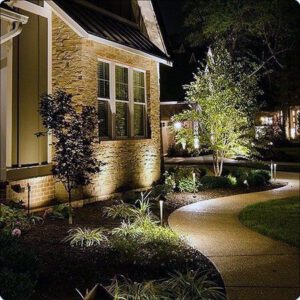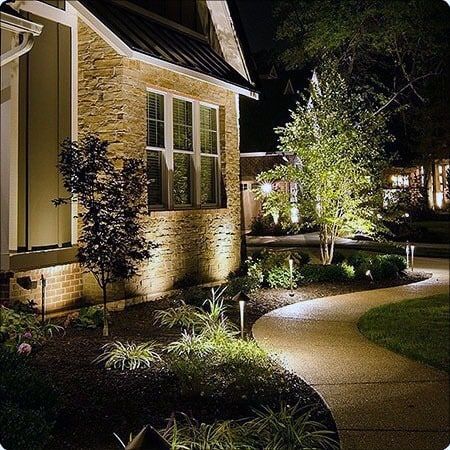Landscape Lighting Orlando, FL is a great way to add beauty and value to your home. It can make a big difference in the appearance of your home after dark. It can highlight unique features such as a majestic palm tree, a cool arched entryway, or creative brickwork.
It can also be used to highlight the natural moonlight effect. This is done by using low-voltage lights aimed downwards.
Landscape lighting is a major investment, but it can provide curb appeal and add value to your home. It can also increase the amount of usable space on your property at night and highlight walkways and architectural features. In addition, it can improve safety and deter crime. It can even make your home more visible to potential buyers, which can be a selling point when you are ready to sell it.
The cost of landscape lighting depends on the type of lights you choose and how much work will need to be done to install them. It also depends on the power source. For example, solar-powered lights are less expensive to install and run, but they do not shine as brightly. If you prefer a more dramatic look, consider installing flood lights that illuminate the whole area. Another consideration is the size of your electrical panel. If it doesn’t have enough capacity to run the lights, you will need to pay an electrician to install a new circuit breaker.
In addition to the cost of lighting fixtures and installation, you will need to factor in the price of a transformer and electrical wires. It is also important to know the number of lights you need, as the more you install, the more expensive it will be. It is also crucial to hire a professional, as the task requires extensive experience and training.
There are many types of landscape lighting available, including recessed and spot lights. You can also use a combination of lighting types to create the best effect. For instance, uplighting trees and walls can create a focal point, while downlights can showcase the beauty of your yard’s architecture.
Landscape lighting is a unique specialization, and working with a professional is the best way to ensure your project is successful. A lighting designer will be able to design a system that fits your budget and accentuates the beauty of your home and outdoor spaces. They will also help you find the right equipment for your needs and budget. They will also take into account the layout of your outdoor living areas, ensuring that you get the most out of your landscape.
Installation
Landscape lighting adds a new dimension to your home’s evening curb appeal and provides a measure of safety for outdoor walkways. While DIY systems are available, professional installation will ensure that the lights enhance rather than overwhelm your home’s natural beauty. Combining different types of lights, ensuring that the light is placed correctly, and illuminating all of your landscape features requires a skilled hand.
Landscape lights are not just for illuminating pathways, but they can also highlight trees, plants, stones, water features and other unique elements of your property. The lighting will highlight the shape, color and texture of these elements, as well as create a mood and ambiance. There are several different ways to illuminate these features, including uplighting and downlighting.
Uplighting is used to highlight dramatic shapes, such as tree trunks or the underside of a canopy, while downlighting is ideal for highlighting smaller trees, shrubs and flowers. Another way to highlight a feature is to use a spotlight or floodlight to cast a broad wash of light onto the feature, creating a silhouette effect that highlights the shape and texture of the object.
When choosing your landscape lighting, look for fixtures with adjustable lumen output. This allows you to control the amount of light that is cast, and can help minimize glare from brighter fixtures. It is also important to choose a transformer that can handle the total wattage of your landscape lights, so be sure to plan accordingly.
Low voltage landscape lighting systems use only 12 volts of electricity, so they are much safer to install than line voltage systems. A professional installer will use a special tool called a quick-connect to make a waterproof connection between the wires and the fixture. This tool is much easier to use than traditional electrical tape and can save you time.
To install your landscape lights, lay out the circuit on a diagram and carefully mark the location of each fixture. Then dig a hole for each light, burying the cable and connector to 2 inches below the surface. After each light is in place, backfill the area with soil and smooth it out.
Maintenance
Landscape lighting can add beauty, safety and security to your home. It can also increase your property value. However, it is important to maintain the system regularly to get the most out of it. The best way to do this is through monthly maintenance services. These services include a thorough inspection of the entire lighting system, cleaning the fixtures and changing out any burned-out bulbs.
Clean the Fixture Lenses
After a long Nebraska winter, your outdoor lights may have mineral deposits on their lenses that can make them appear dimmer than usual. A non-abrasive cloth and CLR type cleaner should remove these residues without damaging the glass.
Clean the Fixture Area
Grass, weeds, plant growth and mulch can fill in or bury the fixtures, preventing them from shining. A little extra weeding and trimming can help keep these obstructions away.
Check and Clean the Fixtures
The metal and plastic components of your landscape lighting can be cleaned with a soft cloth and soapy water. You should never use harsh chemical cleaners on these parts of your lighting system. It is recommended that you use a non-abrasive cloth or a Brillo pad, and always test any cleaner in an inconspicuous area first.
Cleaning the glass of your landscape lighting can be done with a damp cloth or even rainwater. You can also use a mild glass cleaner like Windex, but you should avoid using vinegar or other acids as these can damage the fixture.
It’s important to remember that if your landscape lights are in trees or shrubbery, the plant growth can eventually grow over them and change the original design. Repositioning the fixtures to meet this new landscape design is a crucial part of maintaining your landscape lighting.
Re-Bury Exposed Wiring
One of the most common reasons for landscape lighting failure is exposing wires to the elements. This can be caused by a variety of factors, including pets or children who play in the yard, ground settling or harsh weather. During your maintenance visit, we will rebury any exposed wiring, as well as any other areas where it is required. This will help to alleviate any hazards that could cause someone to trip and fall, as well as to protect the wires from dirt and moisture.
Design
Creating a landscape lighting design can be a complex process. It involves many different aspects, including the layout of your yard and its features, the amount of natural light it receives at different times of day, the size and orientation of trees and other plants, and any hardscaping elements such as decks and patios. It also involves choosing the right type of fixtures and bulbs for your lighting scheme.
The design process begins with a survey of your property and an interview with you about your goals and needs for your outdoor lighting. Your designer will take notes and photos to help them remember your wants and needs when they start designing the layout of your lighting system. They may also suggest ideas that you didn’t think of but would enhance the beauty and functionality of your outdoor space.
Most landscape lighting designers begin their layout by doing a rough sketch of the area. This can help them estimate the distances that light will need to travel. They will also note the types of fixtures that you want to use and any special effects that you are interested in. For example, you might want to highlight a tree with up-lighting or use well lights to wash your walls and structures with soft moonlight.
Once they have a good understanding of the layout and the different types of lighting that you are interested in, your landscape designer will create a detailed design for the project. This will include a sketch of the layout with specific notes about what each fixture is intended to accomplish. It will also contain a list of the type and quantity of fixtures, the bulb, and the voltage they will need to operate.
One of the most important parts of the design is determining the amount of light that you need to highlight your landscape. You want to be able to see the plants and other features of your landscape at night, but you don’t want your landscape lighting to be too bright or it will overtake the beauty of the garden.

